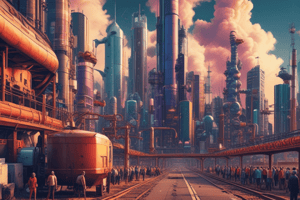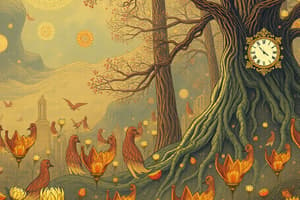Podcast
Questions and Answers
Why are we concerned about human population growth?
Why are we concerned about human population growth?
Human population growth can lead to depletion of resources, environmental degradation, and challenges in sustainability.
Will the world's population double again as it did between 1965 and 2000?
Will the world's population double again as it did between 1965 and 2000?
True (A)
What is the relationship between population growth and environmental impact?
What is the relationship between population growth and environmental impact?
Population growth often leads to increased resource consumption and environmental degradation.
How is human population growth changing in different parts of the world?
How is human population growth changing in different parts of the world?
How does population growth change as a society develops?
How does population growth change as a society develops?
What factors slow down or speed up human population growth?
What factors slow down or speed up human population growth?
Which of the following was a significant effect of agriculture on human population growth?
Which of the following was a significant effect of agriculture on human population growth?
What was a major medical discovery during the Industrial Revolution?
What was a major medical discovery during the Industrial Revolution?
Prior to the Industrial Revolution, human population growth was fixed at what approximate rate?
Prior to the Industrial Revolution, human population growth was fixed at what approximate rate?
What primarily limited early human population growth?
What primarily limited early human population growth?
The human population began to exponentially increase only after the industrial revolution.
The human population began to exponentially increase only after the industrial revolution.
Name one factor that affects human population growth.
Name one factor that affects human population growth.
The population growth during early human history was primarily characterized by _______ growth.
The population growth during early human history was primarily characterized by _______ growth.
Match the demographic measures with their definitions:
Match the demographic measures with their definitions:
Which society development factor is likely to speed up population growth?
Which society development factor is likely to speed up population growth?
Population density does not have any impact on the availability of resources.
Population density does not have any impact on the availability of resources.
What historical factor allowed for a decrease in competition for food among early humans?
What historical factor allowed for a decrease in competition for food among early humans?
Flashcards are hidden until you start studying
Study Notes
Human Population Growth
- Early humans survived as hunter-gatherers with a low population due to density-dependent growth limiting factors such as competition for food, water availability, predators and disease.
- Agriculture reduced the impact of food availability and competition as a density-dependent growth limiting factor, leading to an increase in human population.
- Disease was still present as a limiting factor.
History of Human Population Growth
- Prior to the industrial revolution, human population grew at a fixed rate of about 0.1% per year.
The Industrial Revolution
- The Industrial Revolution led to a transition from hand production methods to machines.
- The use of steam power and factories became more prevalent.
- Significant medical discoveries were made during this time:
- The Germ Theory (Louis Pasteur) - the understanding that microbes cause infection
- Vaccines - injections of dead or weakened viruses that prevent disease
- Antibiotics - chemical compounds that kill bacteria
- Water treatment - filtration and addition of chlorine to water for removing microorganisms and toxins
Exponential Population Growth
- Following the Industrial Revolution, human population growth became exponential, with an increasingly rapid rate and a continuously growing base with a low doubling time.
Human Population Growth
- Human population growth is increasing exponentially.
- The population was low due to density-dependent factors such as competition for food, availability of water, predators and disease.
- People survived by hunting and gathering.
- Agriculture helped reduce the impact of food availability and competition and the human population began to increase.
- Prior to the industrial revolution, human population grew at a fixed rate of about 0.1% per year.
- Human population growth was fixed.
Human Population Growth: The Past and Present
- Population grew consistently before the industrial revolution.
- Since the industrial revolution, growth rates have significantly increased.
- There was a period of exponential growth between 1965 and 2000.
- The growth curve is J-shaped.
Studying That Suits You
Use AI to generate personalized quizzes and flashcards to suit your learning preferences.



